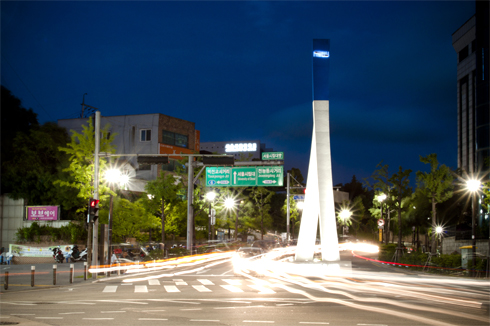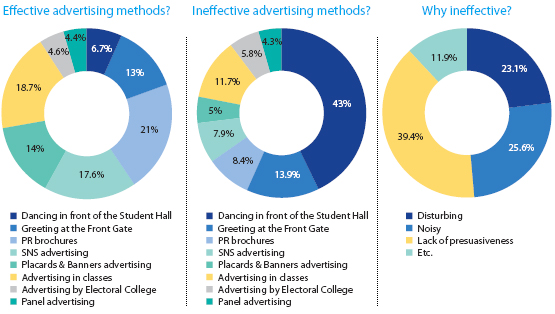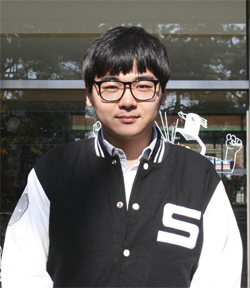At last, the 49th student council was elected with relatively no bumps. However, The UOS Times did hear some complaints over specific campaigning methods that a few of the candidates used. In fact, these kinds of complaints are not new since this negative opinion on campaigning with dancing and chanting was repeatedly brought up during the previous election period. So The UOS Times looked into why this complaint has come to the surface again and again and asked for the opinions of the candidates themselves. At the same time, we looked at how international students viewed UOS’ election campaign culture compared to their respective country’s cultures. After objectively analyzing the current student council election campaign from these three different perspectives of students, candidates, and international students, we are going to determine whether we need a change in the current election campaign culture at the UOS or not.

Discovery of the Problem: Conflicting Opinions Between Students and the Student Council
| Students: Campaigns are more focused on dancing and slogans. We can hardly see the fidelity of their election pledges. |
The UOS Times conducted a survey of 450 students to learn about their complaints on certain campaign methods and attempted to grasp the general opinion about them. The results were as follows: Among the eight campaign methods, students answered that campaign brochures, in-class advertising and SNS ads were the most effective methods. Despite the fact that students did not like the repeatedly handed out brochures from the electoral college, they found that brochures were the best way to be informed about the pledges and the vision of the candidates. Following brochures, students thought in-class advertising was another effective form of campaigning. They said, as long as the in-class advertising does not interrupt the flow of the lecture, it is efficient for them to listen to the candidates’ pledges in person. Students also regarded advertising using SNS, such as Facebook or Kakao Talk, as effective since these can easily spread the candidate’s pledges. However, an overwhelming number of students (251) said that dancing in front of the Student Hall was the most inefficient method. 206 of them responded unanimously that it was not persuasive enough. They added that campaigning through chanting and dancing makes it difficult to understand the pledges, causes noise and are an overall disturbance. Moreover, students argued that rather than focusing on events and noisy marketing campaigns, the candidates should use other practical ways to show their fidelity and vision.
| Candidates: It is especially effective to trigger the interests of indifferent students. Dancing and slogans are a must! |

The UOS Times interviewed, via email, Yang So-jin, the 47th student vice president of ‘Donggodongrak’ and Kim Keun-sik, the 48th student vice president of ‘Muhandongnyeok.’ We asked what kind of campaign strategies they planned to use and which of those were most effective during their campaign period.
What the Student Council Think
47th Student Council (Donggodongnak)
Other than the Front Gate campaign speeches, lunchtime advertising and in-class advertising, there were dancing campaigns all the time. We were in dinosaur suits dancing and handing out brochures to keep the visual interest from the students. We also actively had in-class meetings with students. .
Student Hall dancing and Front Gate greeting
All these were done to grasp the students’ attention. Students could easily recall a green dinosaur when they read the word ‘Donggodongnak’. When we were doing the in-class PR, we wore both suits and dinosaur suits so that students could relate our dinosaur suits with our pledges. In the case of dancing, students really enjoyed it. Some students said it was noisy so we tried to minimize this inconvenience through scheduling dances in specific buildings at times where they would affect classes the least. I think it was important that people related ‘Donggodongnak’ to the image of a green dinosaur. They even called our candidates ‘Dinosaur’ rather than Donggodongnak.
In-class meeting
We needed to let students know about our dream for an ideal student council more than just the existence of ‘Donggodongnak.’ To do that, we had to meet with as many students as possible in person rather than merely campaigning through texts and SNS. The reason why in-class PR was important is that we can communicate sincere messages with the students. Due to these different speeches made by three running-mates (as one team), people did not get bored. Meeting every student in person may not be efficient, but it should be the first priority in a campaign in that we can actually communicate directly with students.
48th Student Council (Muhandongnyeok)
Each method has its own purpose. Brochures and slogans were for transmitting our messages. Dancing was used to attract attention from students. The in-class meetings with students were opportunities to speak with the students about why I am running for this candidacy. Using diverse campaigning methods is important.
In-class meeting
This was the most successful campaign advertising overall. When I randomly called to ask how our electoral stamp was, I heard the answer, ‘It was very touching.’ Of course, I do not mean that the other methods are useless. Dancing, greeting, brochures, SNS, slogans, placards and in-class meetings all have their strengths when they are used in the proper time and situation.
The Cause of the Problem?
The answers to this question were lack of communication and indifference. According to the survey, students and candidates had contrasting viewpoints on the same visual campaign PR (dancing and chanting). For the Student Council, some of them actually thought dancing and chanting had some positive effects. However, students had the opposite opinion. Unlike what the student candidates thought, they saw this visual campaign PR as lacking sincerity and fidelity. They preferred SNS and brochures with written pledges and plans. Therefore, it is clear that candidates and students understand differently on the campaign methods. Despite this difference, both had common in that they have a strong need for communicating and understanding other’s opinions. They simply did not have chances to communicate. Along with this lack of communication, the fundamental problem is that students themselves are indifferent to the election. Thinking more deeply, the reason why dancing popped up in the candidates’ mind was to grasp the students’ attention. If students eagerly paid attention to the election in the first place, this clash would not have occurred. Therefore, all the complaints on visual campaigns from students were primarily because of the lack of communication and ultimately, student’s indifference.
How International Students View UOS Election Campain Culture
The UOS Times looked into how international students saw our current campaign culture and how their campaigns differed from ours.

(Dept. of English language and literature department, international student from China)
In China, about three former-vice-presidents under the former-president automatically become the candidates for the next term’s student president. Therefore, whoever wins the most votes from students and professors becomes president. Because of this, candidates need to maintain good relationships with both professors and students. The Student Council system in China is like a small government with a bottom up hierarchical structure. This structural feature allows only seniors to become student president, and also causes differences in campaign methods as well. Since candidates are readily involved in the Student Council, students are already well aware of each candidate’s experience, activities and characteristics. Therefore, unlike the UOS, which has a variety of advertising methods, Chinese Student Councils use limited advertising mediums and their voting is mostly based on relationships and friendships. The most frequently used advertising is by posters and brochures.
I saw three different student election campaigns going on over three years at the UOS. I think campaigning with dancing and chanting is the most impressive and entertaining method. There is no such advertising at Chinese colleges.

(Dept. Computer Science, a semester exchange student from Czech Republic)
In the Czech Republic, the concept of campus is very different from Korea. Each faculty is regarded as an independent and unique college rather than one comprehensive university. Due to this difference, the Czech Republic has two Student Councils: one for each faculty and one for the overall university. There is no president and vice-president. Instead, two elected students team up with two professors in the same faculty to become senates in the student council for the overall university. Elected candidates represent their respective faculty’s goals and interests. As a result, opposite to what happens in Korea, there are limited campaigning methods. Posters with written pledges are common, and open discussions between candidates are also frequently held.
It is interesting to see various advertising methods at the UOS. Candidates are very passionate about promoting themselves. Above all, dancing in front of the Student Hall was the most impressive. Since I cannot read Korean, posters and brochures written in Korean are unnoticeable to me.
Considering social and political backgrounds in China and the formerly communist Czech Republic, these two countries have clear differences compared to Korea in terms of the composition of the student body, elections, and how they promote campaigns. Both universities in China and Czech Republic had more systematic, bureaucratic, and hierarchical tendencies. Their Student Councils had frequent communication with professors, and had relatively more power to make visible changes on campus. However, above all these differences, the obvious difference is that when it comes to campaign PR, unlike Korea, they all did not place much importance on the campaign itself. Candidates actually used limited methods - only posters - and surprisingly, Chinese and Czech universities both had approximately 50% voting participation, which is very high. Pushing all the social and political difference aside, the two students both agreed that a campaign accompanied with dancing and chanting was interesting and entertaining. However, the Student Council elections are definitely not about having fun and being entertained.
Stepping Stone to Change
As mentioned above, there is a clear opinion gap between the candidates and UOS students. The lack of communication and interaction between each other is the main reason for this opposite opinions on dancing and shouting slogans as advertising methods. However, there is room for change as well. According to our information, both candidates and students said that campaigning during an election is very important. To the question ‘How important is the campaign towards determining your preference to specific candidates?’ about 185 students said advertising activities are quite important, and 139 students said they are important. In addition, just like the candidates, students also positively evaluated advertising during classes as long as they did not interrupt lectures, because there they can easily learn about each candidate’s pledges and sincerity. This shows that both candidates and students think ‘communication’ is important in election campaigns. Above all, more than 250 of 450 students said that they want changes in Student Council election campaigns. They want election campaigns to be more interactive, friendly and sincere, but without going through a superficial pretense. In order to do that, we first need to reconcile their different thoughts on campaigns being accompanied by dancing and chanting.
A Little Change in UOS Campaign Culture
What can we do to bring a better and more interactive election campaign culture to the UOS? First, we need to provide opportunities where both students and candidates can actually communicate with each other. In fact, there was a candidate discussion meeting in the Student Hall from 12 to 1p.m. on Oct. 31. However, not many students showed up to this meeting. Of course, many students were not interested in going to this discussion meeting, if it meant giving up their lunchtime. Besides that, many students said they did not know there was a discussion meeting going on due to a lack of advertising. Therefore, we should encourage students to participate in these kinds of candidate discussion meetings by holding them more frequently, during different times throughout the election season, and of course, with more advertising. Moreover, candidates should visually and verbally expose their ‘pledges’ but not through ‘dancing and chanting.’ They should make their promises public and intrigue students’ attentions by using various mediums such as SNS (Facebook, Twitter, Kakao talk), web pages, videos, and campus radio.
The role of the media on campus is also very important. Even though there are many press organizations such as JBS, UOS News, and The UOS Times, the number of reports on the Student Council election remains very few. The campus press needs to build a bridge linking students to candidates by keeping students updated with detailed information about election processes and campaigns. To be specific, the UOS press needs to cover each candidate’s advertising campaign, and to report the overall summaries on candidate discussion meetings. Most importantly, each press organization should have its own critical view to criticize candidates who try to blind students with impractical pledges and to promote candidates who have practical and desirable promises. With the active role played by the UOS press, students who are exposed to these campus media are not only well aware of candidate’s promises but also actively participate in voting, thus leading to a better UOS election campaign culture.
In conclusion, the complaints over specific campaigning methods were actually caused by the lack of communication between candidates and students as well as student indifference to the election campaign. Although many candidates and their campaign assistants were shouting their slogans in the cold weather, they faced by some unwelcome gazes from other students. We need to be aware that change is more likely when we give candidates heart-warming attention instead of harsh criticism. Students need to pay more attention to each candidate’s pledges and campaigns, participate in open discussion meetings, and finally vote for the most suitable candidate who has executive talent and sincerity. This would be the best and quickest way to promote change in the Student Council election campaigns at the UOS.
Choi Ji-in Reporter/ Kim Hye-ryung Junior Reporter
jiin9110@uos.ac.kr / parisienne314@uos.ac.kr

